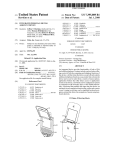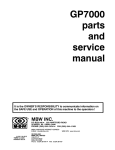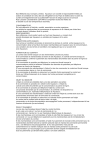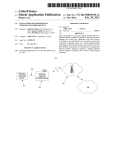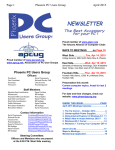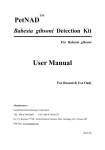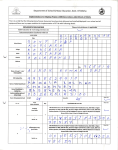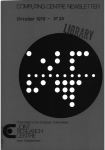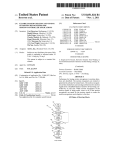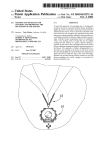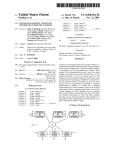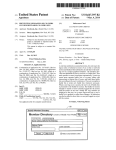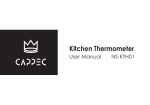Download Using one device to configure and emulate web site content to be
Transcript
US006993575B2 (12) (54) United States Patent (10) Patent N0.: Abkowitz et al. (45) Date of Patent: Jan. 31, 2006 USING ONE DEVICE TO CONFIGURE AND 6,430,624 B1 * EMULATE WEB SITE CONTENT TO BE [)ISPLAYED ()N ANOTHER DEVICE 6,457,060 B1 * 9/2002 Martin et al. ....... .. 6,490,627 B1 * 12/2002 Kalra et al. ..... .. 75 . - - - - ( ) Inventors‘ lgg'lflJAbkowlgl; MOHEWHFVW CA ( )> efemy one: an ranclsco’ . 6,564,250 B1 * 5/2003 Nguyen 6,614,432 B1 * 9/2003 6,615,212 B1 * 9/2003 Dutta et a1. Merrill 709/245 709/231 709/208 .... .. 345/428 707/10 455/419 CAGE)’ Jacob Chnstfort> San 6,684,257 B1 * 709/246 $691615“; EA(US%;AL€IYSY)EIICE J15011, t erton, 6,704,024 B2* 3/2004 Robotham et al. 345/581 6,704,797 B1 * 3/2004 Fields et al. .............. .. 709/246 _ . Notice. 8/2002 Jamtgaard et al. ........ .. 709/246 6,650,893 B1 * 11/2003 Lipsit ............. .. (73) Assignee: Oracle International Corporation, Redwood Shores’ CA (Us) (*) US 6,993,575 B2 . 1/2004 Camut et a1. ....... .. OTHER PUBLICATIONS Greg HeWgill, “Copilot User’s Manual,” Jun. 10, 1997, . . Version 1.0 beta 9, XP-002216883, pp. 1-7. Sub]ect~ to any disclaimer, the term of this G re g HeWgi11,“COpi1Ot_'1-he Windows palmp?ot Emulator,” patent is extended or adJusted under 35 1997 XP_002216884 pp 1_3 U.S.C. 154(b) by 975 days. ’ ’ ' ' * cited by examiner (21) Appl. No.: 09/773,982 (22) Filed; _ _ _ Primary Examiner—Abdullahi E. Salad Jam 31, 2001 (374)snag/1146p)», Agent, or Firm—Hickman Palermo Truong & ec er, (65) Prior Publication Data US 2001/0041973 A1 (57) Nov. 15, 2001 Related US. Application Data A method and apparatus are disclosed for using one device (60) Provisional application No. 60/184,211, ?led on Feb. 22 2000 ’ (51) (52) 58 ( ) ' tqqm?gure mfprmanon to .e.dlsplayed. on another deylce With different display capabilities. Techniques are described for receiving input on a management device, Which speci?es Int CL G061; 15/177 U S C] (200601) 709/220_ 709/246_ 715/778 S h ’ ’709/246 F: I'd "" 1e 0 70$;L5ca2;%n22e2a§27 681 619’ 345/1 1 ’3 4_ _715;527 E23 ’778_ 358h 15? ' _ ' ’ 703/23’ 4557419 56 1’ See application ?le for Complete se’arch histogy ' information for display on a target device. The management device generates an image of hoW the speci?ed information Will appear When displayed on the target device. Additional input may be received on the management device that changes the information to be displayed or the format of the information. The management device modi?es the image to re?ect such changes. The management device may display an image of the target device that includes the display of the ' selected information. The management device may also emulate the target device, thereby permitting a user to . References Cited (56) ABSTRACT simulate physical use of the target device by manipulating U.S. PATENT DOCUMENTS the image of the target device on the management device. 6,078,936 A * 6/2000 Martin et a1. ............. .. 715/527 6,390,371 B1 * 5/2002 Armga et al. ........ .. 235/472.01 58 Claims, 7 Drawing Sheets 00 /i . g? Personalize my Pieierences Select device ‘g > Horoscope ' slum Search Select the device you ‘wish to associate with this account. ‘ vwne The device adiiess Will be used for receiving alerts. v Q _ y 1!‘ M150 ‘1 é Nokia 7110 e N60 Point Pm Q! a O @ 152 6/154 Motorola 17089 155 Erickson r380 = 120 Device Address: I [email protected] I mi 8 \ k 110 a 100 130 U.S. Patent Jan. 31, 2006 38 6: 9.62m m5;. @@ 5m Sheet 1 0f 7 02/ $5 mm? 3Q@965 in: 2a0w.e53:2 3826m w2I.EoZ 830:5>29.a"5m 582.0m2 % 50¢2.:> a US 6,993,575 B2 U.S. Patent Jan. 31, 2006 US 6,993,575 B2 Sheet 2 0f 7 _l l I 1 1 | | 1 | 1 w2:05o24.w:5 wmo_>wmo z . o E m b F j Z w O Q w 5 3 0 m 2 F wm<>EO .wow52: U.S. Patent Jan. 31, 2006 Sheet 4 0f 7 US 6,993,575 B2 400 * Stocks * Wine Search Entertainment Point Home 420 U.S. Patent Jan. 31, 2006 5m. Sheet 6 6f 7 Emwc @ O@ {HI0% E61 3 O I J $s52.:95 E2:35 US 6,993,575 B2 / 0mm N;22%a3a a26.2%E25 $5 E5E / 2% £.mAl85ucwm £5E:E:26 25£5E5 .; @E.N:Esmug s5 " X E ; g2 5.2 5.3 w$a2>2tc8h.3 6.55g2i% AH o85%m22AaL.26.g6mia? 5d38a? US 6,993,575 B2 1 2 USING ONE DEVICE TO CONFIGURE AND EMULATE WEB SITE CONTENT TO BE DISPLAYED ON ANOTHER DEVICE immobility by providing large color screens, sophisticated sound output, signi?cant processing poWer, ergonomic key board input, and an easy-to-use selection device such as a RELATED APPLICATION devices achieve their portability at the expense of screen siZe mouse, track ball, or track pad. Conversely, small mobile and user-input ease-of-use. This application claims domestic priority from prior US. provisional application Ser. No. 60/184,211 ?led Feb. 22, 2000, the entire disclosure of Which is hereby incorporated by reference as if fully set forth herein. The World Wide Web contains far more content than can be displayed on any given device. Consequently, mecha 10 nisms have been provided that alloW users of Web-enabled devices to specify the content that they desire to see. Traditionally, the user of a Web-enabled device uses the FIELD OF THE INVENTION user-input mechanism of the Web-enabled device to specify the content to be displayed on the Web-enabled device. This practice Works Well When the Web-enabled device is a The present invention relates to providing services to clients and, more speci?cally, to using one device to con ?gure and emulate Web site content to be displayed on another device. 15 enabled device is a mobile phone With only a feW buttons for BACKGROUND OF THE INVENTION 20 The World Wide Web includes a netWork of servers on the Internet, each of Which is associated With one or more pages associated With a server provide information and fore often referred to as “listeners”. Users of the World Wide Web use a client program, receiving user input, the process of specifying content becomes aWkWard and tedious. One approach to avoiding the tedious process of using the input mechanism of a mobile device to specify Web content for the mobile device involves the use of a general purpose computer for specifying the sources, applications, or ser HTML (Hypertext Markup Language) pages. The HTML hypertext links to other documents on that and (usually) other servers. Servers communicate With clients by using the Hypertext Transfer Protocol The servers listen for requests from clients for their HTML pages, and are there general purpose computer system With sophisticated easy to-use input mechanisms. Unfortunately, When the Web vices to access from the mobile device. The interface 25 presented to the computer for receiving the user input by Which the user selects the desired content sources and applications may itself be presented in the form of one or more Web pages. While this approach eliminates the dif?culty associated 30 With using the user interface of the mobile device, it raises displaying the page sends a request over the Internet to the listener associated With the Universal Resource Locator 35 information on a mobile device is typically a major factor in deciding What should be displayed on a mobile device. If the decision of What to display on a mobile device is made Without taking into account hoW that information Will referred to as a broWser, to request, decode and display information from listeners. When the user of a broWser other problems. Speci?cally, the ultimate appearance of selects a link on an HTML page, the broWser that is (URL) speci?ed in the link. In response to the request, the listener transmits the requested information to the broWser that issued the request. The broWser receives the informa tion, presents the received information to the user, and aWaits the next user request. appear, the results may be completely unacceptable. For example, a user may specify that the neWs page sent to the mobile device include sound and photos. HoWever, the sound and video capabilities of the device may be such that 40 Traditionally, the information stored on listeners is in the form of static HTML pages. Static HTML pages are created and stored at the listener prior to a request from a Web broWser. In response to a request, a static HTML page is merely read from storage and transmitted to the requesting 45 broWser. Currently, there is a trend to develop listeners that mobile device, and (4) repeating steps (2) and (3) until the 50 appearance of the selected Web content on the mobile device is acceptable to the user. Unfortunately, such an iterative process may be just as tedious as attempting to use the user interface of the mobile 55 becomes particularly laborious When a user must go through ting the dynamically constructed HTML page to the request ing broWser. Another trend is to expand Internet access to devices other than conventional computer systems. For example, Wireless phones have been developed that include embedded Web device to specify the Web content. Further, the process it for each of multiple mobile devices oWned by the user. Based on the foregoing, it is clearly desirable to provide improved techniques for specifying Web content to be dis played on Web-enabled devices that have relatively restric broWsers. Due to siZe and cost constraints, the “micro broWsers” contained in these devices have very limited functionality relative to the broWsers that have been devel oped for full-?edged computer systems. HoWever, devices With embedded micro broWsers are usable in circumstances of (1) using the general purpose computer to specify the Web content for the mobile device, (2) accessing the content from the mobile device, (3) based on the appearance of the content on the mobile device, using the general purpose computer to make adjustments to the Web content for the respond to broWser requests by performing dynamic opera tions. For example, a listener may respond to a request by issuing a query to a database, dynamically constructing a Web page containing the results of the query, and transmit the sound played by the device is unintelligible, and the photos appear on the device as black boxes. To ensure that the ultimate appearance of the information Will be acceptable, a user may engage in the iterative process 60 tive display and/or input mechanisms. under Which using a conventional computer system is impractical. The number of device types that are able to display Web content, in one form or another, continues to increase. As the number of such Web-enabled device types increases, so does the variation in the capabilities of the devices. For example, general purpose computer systems compensate for their SUMMARY OF THE INVENTION Techniques are provided for using a management device 65 to con?gure information to be displayed on a target device that has different display capabilities than the management device. According to one aspect of the invention, a user US 6,993,575 B2 3 4 speci?es via the management device the information to be displayed on the target device. The management device displays an image of hoW that information Would appear on DETAILED DESCRIPTION OF THE PREFERRED EMBODIMENT the target device. For example, a user may use a general purpose computer to select via a Web-based interface the information to be displayed on a mobile device. The com Techniques are described for using a ?rst device to emulate the display of content on a second device that has puter displays an image of hoW the selected information alloWing the ultimate appearance of the content of the second device to be considered While using the ?rst device to specify the content for the second device. In the folloWing description, for the purposes of explanation, numerous spe ci?c details are set forth in order to provide a thorough understanding of the present invention. It Will be apparent, hoWever, to one skilled in the art that the present invention may be practiced Without these speci?c details. In other instances, Well-knoWn structures and devices are shoWn in block diagram form in order to avoid unnecessarily obscur different display capabilities than the ?rst device, thereby Would appear on the screen of the mobile device. The user may use the management device to change the information to be displayed on the mobile device, the format for dis 10 playing the speci?ed information, or any combination thereof. In another aspect, the management device may display an image of the target device, Where the image portrays hoW the 15 speci?ed information Will appear on the target device. The user via the management device may also manipulate the image of the target device to simulate the use of the physical ing the present invention. Functional OvervieW target device, With the image emulating the behavior of the target device in response to the user’s manipulations. For example, a computer may display an image of a mobile phone shoWing a list of local restaurants. The user may then Techniques are provided Which alloW users of one device to con?gure content to be delivered to a target device, Where the mechanism that provides the interface for content selec use a mouse to click on the buttons of the phone on the tion also provides an image that emulates the target device, image, such as to simulate pressing the up and doWn arroW keys on the physical phone. The image of the phone on the computer’s display Would then respond to the user’s mouse clicks by scrolling the display on the screen of the phone 25 and displays hoW the selected content Will appear on the target device. Specifying a Set of Target Devices image. The user may manipulate the information to be displayed on the phone by manipulating the contents of the According to one embodiment, a user With multiple devices uses one of the devices (hereinafter referred to as the display screen on the phone image on the computer. Other aspects of the invention include, but are not limited to, the simultaneous display of hoW the user speci?ed “management device”) to specify the content to be sent to one or more other devices. Both the management device and the other devices may be referred to as “Web-enabled” information Will appear on more than one device, concur rently displaying multiple screen displays for a particular target device, or any combination thereof. 35 receiving information from the World Wide Web. While such information is typically in the form of HTML pages, BRIEF DESCRIPTION OF THE DRAWINGS The present invention is illustrated by Way of example, and not by Way of limitation, in the ?gures of the accom panying draWings and in Which like reference numerals refer the embodiments described herein are not limited to devices 40 Furthermore, While the techniques described herein shall be described With reference to an embodiment in Which the FIG. 1 is an illustration of a target device selection user interface that may be provided over the Web and of a target device that is displayed in a frame of a Web page, according to one embodiment of the invention; FIG. 2 is a block diagram that illustrates a high level overvieW of a system for using one device to con?gure and emulate Web site content to be displayed on another device, according to one embodiment of the invention; FIG. 3 is an illustration of an image of a target device that emulates hoW an actual target device Would depict the Web content that has been selected, according to one embodiment 45 of the invention; 55 embodiment of the invention; FIG. 5 is an illustration that shoWs hoW menus displayed in a control shoWn on a management device correspond to menus shoWn on the image of a target device, according to one embodiment of the invention; FIG. 6 is an illustration of a multi-screen previeW, accord ing to one embodiment of the invention; and FIG. 7 is a block diagram that illustrates a computer system upon Which an embodiment may be implemented. that exchange HTML pages. Pages in other formats may be exchanged, such as XML (extensible markup language) or WML (Wireless markup language). to similar elements and in Which: FIG. 4 is an illustration in Which a target device is displayed in its oWn WidoW in a broWser, according to one devices, meaning that they are capable of sending and World Wide Web is the information source, the techniques described herein are applicable to any environment in Which (1) a target device is able to display information from a source, and (2) a management device is able to specify the content or format of that information. Due to the sophistication of the display and input mecha nisms available for general-purpose computers, a general purpose computer Will typically be chosen to be the man agement device. HoWever, the device selected to be the management device may vary from situation to situation, and this embodiment is not limited to the selection of any particular type of management device. The user causes the management device to retrieve data from a Web server. According to one embodiment, the data causes the broWser of the management device to display user interface controls that alloW the user to select a set of one or more “target” devices. The target devices are the Web-enable devices to Which a speci?ed set of Web content Will be delivered, Where the user uses the management device to select the speci?ed set of Web content. FIG. 1 illustrates a “target device selection” user interface 65 110 that may be provided to the management device over the Web, according to one embodiment. Selecting a target device using target device selection user interface 110 causes a US 6,993,575 B2 5 6 visual depiction of the target device 120 to be displayed on the management device. FIG. 1 also illustrates an embodi ment in Which the visual depiction of the target device 120 for Which virtual device 208 Was loaded. In the illustrated is displayed in a frame 130 of a Web page 100 that contains user interface 110 in another frame. FIG. 2 illustrates a system con?gured according to one embodiment of the invention. The system includes a Web server 200, a management device 250 and a target device 252. Web server 200 includes a content selection unit 204 and a device emulation unit 206 for loading one or more virtual devices 208, and a transformation engine 212 com prising one or more transformation units 210. Content 10 Advantageously, the embodiments described alloW a user selection unit 204 includes one or more softWare modules 224 con?gured to transmit Web pages to management device 250. The transmitted Web pages may include, for example, 15 Web page 100 illustrated in FIG. 1 that includes user interface controls 150, 152, 154, and 156 for the user to specify one or more target devices. In response to the user selecting target devices, informa tion that identi?es the selected devices is sent back to Web server 200. This information is stored in a pro?le for the user that made the selection, Which resides With other user pro?les in a repository 202 on a storage device accessible to Web server 200. In addition to storing data that indicates the target device selection, content selection unit 204 sends a message to the device emulation unit 206 to cause virtual devices 208 to be loaded for the selected target devices. In embodiment, virtual device 208 receives the data for the home page from transformation unit 210 that, in turn, receives the data from the applications and services 254. As virtual device 208 receives the data, virtual device 208 interprets the data and presents it in a fashion Which, When decoded by the broWser on management device 250, com pletely mimics the effect of similar XML being transformed into the markup for the corresponding target device, such as WML, and vieWed on the target device. to con?gure and emulate Web content for a target device, such as a mobile phone, using a management device, such as a general purpose computer like a desktop or laptop personal computer. This advantage can be achieved regardless of the format of the original Web content or the format necessary for input to the target device. And there is also no need for the user to repeatedly con?gure the information and check hoW it appears on the target device. Rather, the user can con?gure the information for the target device on the man agement device and revieW hoW it Would appear on the emulated image of the target device on the management device. 25 Web Content Selection Once a set of target devices has been selected, the user is presented With a user interface that alloWs the user to select the present example, it shall be assumed that a single target device Was selected. Consequently, only virtual device 208 has been loaded by device emulation unit 206 for manage Web content for the target devices. According to one embodiment, a Web content selection user interface is dis played in one frame of a Web page, While an image of a ment device 250. Virtual device 208 is a software component that is con target device is concurrently displayed in another frame of the Web page. The image of the target device is not static. ?gured to receive data in a particular format, and to generate Rather, the image of the target device accurately depicts hoW code that causes that data to be displayed on the manage ment device in the same Way as it Would be displayed on the 35 the currently selected Web content Will appear When dis played on the actual target device. When the user manipu lates the content selection user interface to change the content to be sent to the target device, the image of the target target device that corresponds to the virtual device. In the illustrated system, Web server 200 receives the content from applications and services 254, Which in turn receive it from a Web integration unit 240 that ultimately receives the content from HTML sources 214. According to one embodi device is updated to re?ect the change in speci?ed content. 40 ment, the output generated by the applications and services 254 is in XML (extensible markup language) format. Trans Without even having the target device present during the content selection process. FIG. 3 shoWs hoW an image 320 of a target device formation engine 212 includes transformation units 210 for converting that XML data to the input format expected by other devices, including the virtual device 208. In the 45 user interface, such as user interface 110 in FIG. 1. The initial appearance of the image is generated as described above. Auser may change a Web content selection, such as unchecking a checkmark or adding neW information by checking a checkmark, such as an object 330 in dialog box 310 of the user interface. Referring to FIG. 2, such a change is re?ected in the user’s con?guration Within repository 202, Which describes 55 device 208 may be con?gured to receive HTML input, XML input, or some other form of input such as WML (Wireless the selection overlay chosen at any time by any user. Referring back to FIG. 3 and dialog box 310, as soon as the user presses a “Submit Changes” object 340, repository 202 is updated. Back in FIG. 2, virtual device 208 is noti?ed to re-load the user Web content. In response to the noti?cation, virtual device 208 reads the revised user con?guration markup language). If the input format required by virtual device 208 is different than the format in Which the data is received by Web server 200, then an appropriate transfor mation unit 210 must process the content before it is supplied to the virtual device 208. When virtual device 208 is loaded, it requests data for its “home page”. The data that constitutes the home page of the virtual device 208 is identi?ed in the user pro?le of the user emulates hoW the actual target device Would depict the Web content that has been selected using a dialog box 310 of a illustrated system, the management device 250 is a general purpose computer that is executing a broWser, so the code generated by virtual device 208 is HTML code that is incorporated into the Web pages sent by Web server 200 to management device 250. The speci?c components of Web server 200 Will vary from implementation to implementation depending on a variety of factors including the format of the data generated by the applications and services 254, the format expected by virtual device 208, and the format expected by the management device 250. For example, applications and services 254 may generate HTML code, rather than XML. In addition, virtual Thus, the user can immediately take into account the ulti mate appearance of selected content on the target device information from repository 202, retrieves the correspond ing content, and sends data to management device 250 that causes the display of image 320 in FIG. 3 of the target device in to be adjusted accordingly, creating the experience of 65 instant simulation of the changes made. It Will be appreciated that While the above examples illustrates the user interface in one frame of a Web page and US 6,993,575 B2 8 7 the image of the target device in another frame of a Web page, the user interface and image of the target device can To control the appearance of the information on the be in their oWn WindoWs of an Internet browser. For device, the interface on the management device has speci?c menus closely mimicking the target device. For example, example, FIG. 4 illustrates an image 420 of a target device in a WindoW 400 that does not contain other features of the FIG. 5 illustrates hoW a set of menus 530 displayed in a control 540 shoWn on a user interface 510 of the manage user interface. ment device correspond to a set of menus 550 shoWn on an image 520 of the target device. HoWever, the functionality of the management device is Emulated Target Device Behavior The Web content speci?ed for a target device may include more than a single static page of information. For example, 10 not limited to the functionality of the target device. Conse quently, the menu for selecting content includes more items than can be simultaneously shoWn on the target device, and the menu is able to take advantage of Web-like user interface the Web content may include a series of pages that are linked in a hierarchical fashion. Each Web-enabled device Will metaphors. For example, by clicking on a menu item in the user interface and manipulating user interface controls, a Web content that is sent to it. According to one embodiment, 15 user can select an item and then change the order and appearance of that item. In response to the user input, the the image of a target device that is displayed on the typically have some mechanism for navigating through the controls on the actual device Would have on the actual changes Will be instantly re?ected by the Virtual Device. As explained above, the instant change in the device image is achieved through updating con?guration data in the reposi tory, and causing the Virtual Device to request and interpret device. This emulation of the actual device effectively data based on the neW con?guration data. managing device is implemented in such a Way that manipu lation of the controls depicted on the image has the same effect on the image as manipulation of the corresponding creates a Virtual Device of the actual device on the manag Target Device Sets ing device. For example, the Web uses very different user interface of the physical device, by making the image of the physical As mentioned above, the user of the managing device is not limited to the selection of a single target device. Rather, the user may select multiple target devices. Using the device (such as a mobile phone) “dynamic.” This means that managing device to change the Web content speci?cation, metaphors, such as clicking With mouse instead of pushing on buttons. The Virtual Device implements a close likeness the areas shoWing the phone buttons are sensitive to a mouse the user affects the Web content that Will be sent to every click. This Way the user essentially uses the mouse as a target device in the set. If the visual display of the managing device is large enough, the Web content sent to the managing device may cause the managing device to concurrently display images of all of the target devices. The images Would depict hoW the speci?ed content Will ultimately appear on the corresponding target devices. In situations in Which there are large numbers of target devices, or Where the display of the managing device is not sufficiently large, it may be desirable to display images of less than all of the target devices, and to provide user interface controls for selecting Which target device images to display. virtual ?nger on the Web to activate the mobile phone as in the physical World. The Virtual Device interprets these inputs as Would the physical device, and responds With the same behavior in the image of the mobile phone in the display of the managing device. This alloWs the user to “use” the phone via the managing device to simulate hoW the 35 phone Will actually Work in the physical World, Without having to use the actual phone. Format Manipulation 40 Multi-Screen PrevieW According to one embodiment, the image of a target device is implemented in a manner that alloWs the format of the selected Web content to be altered by manipulating the display of the Web content on the image of the target device. 45 The approach described herein provides the ability to manually navigate through the many layers of screen layouts For example, a user may select a series of menu items to be on the Virtual Device exactly as a user Would navigate displayed on the target device. In response to the selection, through screens of the corresponding target device. HoW ever, such navigation may often require a great amount of key pressing. To alleviate this, the user can chose a multi screen previeW Where a larger set of information is displayed in consecutive ‘mini-screens’, each of Which mimics the look of different screen layer of the target device. Similarly, the visual image of the target device is updated to display hoW those menu items Would appear on the target device. The format of the menu items on the displayed image is the same format that the menu items Will have on the actual target device. The format of the content includes, for example, the order of the menu items, the font of the text, the siZe of the font, and (depending on the capabilities of the target device) the color of the text. According to one embodiment, the image of the target device is implemented such that the user may affect the one or more unrelated screen displays of information for the target device can be shoWn in a multi-screen previeW on the 55 management device. FIG. 6 illustrates this feature. A user interface 610 dis plays mini-screens 630, 640, and 650, all of Which shoW device by directly manipulating the display on the image of hoW the appearance of their respective content Would appear on an image 620 of the target device and thus on the physical the target device. For example, the user may operate a mouse attached to the management device to “drag” one menu item from one position to another position on the display screen target device itself. This is achieved by quickly passing all of the user’s preferred content through the inner logic of the chosen format of the Web content that is to be sent to the target of the target device image. In response, the format of the Web content that Will be sent to the target device is changed such that When the content is displayed on the actual target device, the menu item Will appear in the neW position. Virtual Device(s), providing typical user input automati 65 cally, and recording the output. In the ?nal stage, all of these outputs are collated in a previeW screen for easy overvieW and validation of a larger set of services. US 6,993,575 B2 10 Fine-Granularity Selection of Web Content implemented by computer system 700 in response to pro cessor 704 executing one or more sequences of one or more for allowing users of one device, such as a general purpose instructions contained in main memory 706. Such instruc tions may be read into main memory 706 from another computer, to specify, with ?ne granularity, the web content computer-readable medium, such as storage device 710. for another device, such as a mobile device. For example, using the mechanism, the owner of a mobile device may Execution of the sequences of instructions contained in main memory 706 causes processor 704 to perform the process con?gure, using a general purpose computer, a user pro?le that determines the speci?c information that is sent to the mobile device. Thus, the user is not limited to specifying general sources of information (eg cable news network (CNN) or The Weather Channel), but may specify a subset steps described herein. In alternative embodiments, hard wired circuitry may be used in place of or in combination with software instructions to implement the invention. Thus, According to one embodiment, a mechanism is provided 10 embodiments of the invention are not limited to any speci?c combination of hardware circuitry and software. of the content supplied by those sources (eg National The term “computer-readable medium” as used herein refers to any medium that participates in providing instruc Football League (NFL) scores, or the scores of a particular NFL team), thereby providing for ?ner granularity in the 15 tions to processor 704 for execution. Such a medium may take many forms, including but not limited to, non-volatile media, volatile media, and transmission media. Non-volatile web content for the mobile device. Various sources have allowed general-purpose computer users to achieve this level of customiZation, through user input entered at the computer, relative to the content deliv media includes, for example, optical or magnetic disks, such as storage device 710. Volatile media includes dynamic ered to their general-purpose computer. However, the tech memory, such as main memory 706. Transmission media niques described herein allow general-purpose computer includes coaxial cables, copper wire and ?ber optics, includ ing the wires that comprise bus 702. Transmission media can users to achieve this level of customiZation, through user input entered at the computer, relative to the content deliv ered to their mobile devices. Further, techniques are pro vided that allow users to use general-purpose computers to: also take the form of acoustic or light waves, such as those generated during radio-wave and infra-red data communi 25 1) specify what information or which applications to down cations. Common forms of computer-readable media include, for example, a ?oppy disk, a ?exible disk, hard disk, magnetic load to a mobile device, and how the information or appli cations are customiZed for the speci?c user, and 2) enable tape, or any other magnetic medium, a CD-ROM, any other the user to preview selected web content directly on web site optical medium, punchcards, papertape, any other physical before accessing the web content from the mobile device. medium with patterns of holes, a RAM, a PROM, and EPROM, a FLASH-EPROM, any other memory chip or Hardware Overview cartridge, a carrier wave as described hereinafter, or any other medium from which a computer can read. FIG. 7 is a block diagram that illustrates a computer system 700 upon which an embodiment of the invention Various forms of computer readable media may be 35 involved in carrying one or more sequences of one or more may be implemented. Computer system 700 includes a bus 702 or other communication mechanism for communicating information, and a processor 704 coupled with bus 702 for instructions to processor 704 for execution. For example, the processing information. Computer system 700 also includes a main memory 706, such as a random access memory 40 (RAM) or other dynamic storage device, coupled to bus 702 for storing information and instructions to be executed by use an infra-red transmitter to convert the data to an infra-red processor 704. Main memory 706 also may be used for storing temporary variables or other intermediate informa tion during execution of instructions to be executed by processor 704. Computer system 700 further includes a read only memory (ROM) 708 or other static storage device coupled to bus 702 for storing static information and instruc signal. An infra-red detector can receive the data carried in the infra-red signal and appropriate circuitry can place the 45 data on bus 702. Bus 702 carries the data to main memory 706, from which processor 704 retrieves and executes the instructions. The instructions received by main memory 706 may optionally be stored on storage device 710 either before or after execution by processor 704. Computer system 700 also includes a communication interface 718 coupled to bus 702. Communication interface 718 provides a two-way data communication coupling to a tions for processor 704. A storage device 710, such as a magnetic disk or optical disk, is provided and coupled to bus 702 for storing information and instructions. Computer system 700 may be coupled via bus 702 to a display 712, such as a cathode ray tube (CRT), for displaying network link 720 that is connected to a local network 722. For example, communication interface 718 may be an information to a computer user. An input device 714, includ ing alphanumeric and other keys, is coupled to bus 702 for instructions may initially be carried on a magnetic disk of a remote computer. The remote computer can load the instruc tions into its dynamic memory and send the instructions over a telephone line using a modem. Amodem local to computer system 700 can receive the data on the telephone line and 55 integrated services digital network (ISDN) card or a modem communicating information and command selections to to provide a data communication connection to a corre processor 704. Another type of user input device is cursor sponding type of telephone line. As another example, com control 716, such as a mouse, a trackball, or cursor direction munication interface 718 may be a local area network keys for communicating direction information and com (LAN) card to provide a data communication connection to a compatible LAN. Wireless links may also be implemented. In any such implementation, communication interface 718 mand selections to processor 704 and for controlling cursor movement on display 712. This input device typically has two degrees of freedom in two axes, a ?rst axis (e.g., X) and a second axis (e.g., y), that allows the device to specify positions in a plane. The invention is related to the use of computer system 700 65 sends and receives electrical, electromagnetic or optical signals that carry digital data streams representing various types of information. Network link 720 typically provides data communication for implementing the techniques described herein. Accord through one or more networks to other data devices. For ing to one embodiment of the invention, those techniques are example, network link 720 may provide a connection US 6,993,575 B2 11 12 through local network 722 to a host computer 724 or to data 3. The method as recited in claim 1, further comprising: equipment operated by an Internet Service Provider (ISP) receiving second input from said ?rst device, Wherein said second input speci?es a format for displaying the 726. ISP 726 in turn provides data communication services through the World Wide packet data communication netWork information on said second device; and in response to said second input, causing said ?rst device noW commonly referred to as the “Internet” 728. Local netWork 722 and Internet 728 both use electrical, electro magnetic or optical signals that carry digital data streams. The signals through the various netWorks and the signals on netWork link 720 and through communication interface 718, Which carry the digital data to and from computer system to generate, based on said format, a modi?ed ?rst visual depiction of hoW the information Will appear When displayed on said second device. 4. The method as recited in claim 1, further comprising: 10 receiving second input from said ?rst device, Wherein said 15 second input modi?es hoW the information is to appear When displayed on said second device; and in response to said second input, causing said ?rst device to generate a modi?ed ?rst visual depiction of hoW the information Will appear, as modi?ed by said second input, When displayed on said second device. 5. The method as recited in claim 1, further comprising: causing said ?rst device to generate a third visual depic tion of hoW the information Will appear When displayed 700, are exemplary forms of carrier Waves transporting the information. Computer system 700 can send messages and receive data, including program code, through the netWork(s), net Work link 720 and communication interface 718. In the Internet eXample, a server 730 might transmit a requested code for an application program through Internet 728, ISP 726, local netWork 722 and communication interface 718. In accordance With the invention, one such doWnloaded appli cation implements the techniques described herein. on a third device, Wherein said third device has differ ent display capabilities than either said ?rst device or said second device. 6. The method as recited in claim 5, Wherein said ?rst The received code may be eXecuted by processor 704 as it is received, and/or stored in storage device 710, or other non-volatile storage for later execution. In this manner, visual depiction and said third visual depiction are displayed computer system 700 may obtain application code in the form of a carrier Wave. 25 In the foregoing speci?cation, the invention has been described With reference to speci?c embodiments thereof. It Will, hoWever, be evident that various modi?cations and changes may be made thereto Without departing from the broader spirit and scope of the invention. The speci?cation and draWings are, accordingly, to be regarded in an illus second device, further comprising: receiving second input from said ?rst device, Wherein said second input speci?es additional information that speci?es a second set of data to be displayed on said second device, and wherein said ?rst set of data and said second set of data are not displayed concurrently trative rather than a restrictive sense. What is claimed is: 1. A method of using a ?rst device to con?gure informa tion to be displayed on a second device that has different on said second device; and 35 display capabilities than said ?rst device, the method com prising the computer-implemented steps of: receiving ?rst input from said ?rst device, Wherein said ?rst input speci?es the information to be displayed on said second device; causing said ?rst device to generate a ?rst visual depiction of hoW the information Will appear When displayed on said second device; based on said ?rst input, storing data that speci?es the information to be displayed on said second device; based on said data, transmitting for display on said second device the information that said data speci?es; causing said ?rst device to generate a second visual 40 45 depiction, such that said third visual depiction depicts said ?rst visual depiction of hoW the information Will appear When displayed on said second device and (b) a second visual depiction of hoW the additional informa tion Will appear When displayed on said second device. 8. The method as recited in claim 1, Wherein said ?rst device is a general purpose computer. 9. The method as recited in claim 1, Wherein said second device is con?gured to communicate through a Wireless connection. 10. The method as recited in claim 9, Wherein said second device is a mobile phone. 11. The method as recited in claim 1, Wherein said ?rst input from said ?rst device is received through a ?rst frame of a WindoW that depicts a Web page and Wherein said ?rst 55 said second device displaying the information. 2. The method as recited in claim 1, further comprising: receiving second input from said ?rst device, Wherein said second input modi?es the information to be displayed portion of content available from a service. 13. The method as recited in claim 1, Wherein the infor mation to be displayed on said second device is an appli cation available from a service. 14. A method of using a ?rst device to con?gure infor mation to be displayed on a second device that has different display capabilities than said ?rst device, the method com on said second device; in response to said second input, causing said ?rst device to generate a modi?ed ?rst visual depiction of hoW the information, as modi?ed by said second input, Will appear When displayed on said second device; and based on said second input, causing a change to the information displayed on said second device. causing said ?rst device to display concurrently both (a) visual depiction is displayed in a second frame of said WindoW. 12. The method as recited in claim 1, Wherein the infor mation to be displayed on said second device is a particular depiction, Wherein said second visual depiction depicts said second device; and causing said ?rst device to generate a third visual depic tion, Wherein said third visual depiction is a combina tion of said ?rst visual depiction and said second visual concurrently on said ?rst device. 7. The method as recited in claim 1, Wherein the infor mation speci?es a ?rst set of data to be displayed on said prising the computer-implemented steps of: receiving ?rst input from said ?rst device, Wherein said ?rst input speci?es the information to be displayed on said second device; 65 causing said ?rst device to generate a ?rst visual depiction of hoW the information Will appear When displayed on said second device; US 6,993,575 B2 14 13 based on said ?rst input, storing data that speci?es the information to be displayed on said second device; based on said data, transmitting for display on said second device the information that said data speci?es: based on said second user input, causing a change to the content displayed on said mobile device. 18. The method as recited in claim 16, further comprising: receiving additional data on said general purpose com causing said ?rst device to generate a second visual puter, Wherein said additional data is generated in depiction, Wherein said second visual depiction depicts said second device; response to user interaction With said second image of the mobile device; and based on said additional data, emulating hoW said mobile receiving data from said ?rst device, Wherein said data is generated in response to user interaction With said second visual depiction of said second device; and based on said data, causing said ?rst device to visually emulate hoW said second device Would operate in 10 response to said user interaction. 15. A method of using a ?rst device to con?gure infor mation to be displayed on a second device that has different 15 device Would operate in response to said user interac tion. 19. The method as recited in claim 16, Wherein the content speci?es a ?rst set of data to be displayed on said mobile device and further comprising: receiving second user input on said general purpose computer, Wherein said second user input speci?es display capabilities than said ?rst device, the method com additional content that speci?es a second set of data to prising the computer-implemented steps of: be displayed on said mobile device, and Wherein said receiving ?rst input from said ?rst device, Wherein said ?rst input speci?es the information to be displayed on said second device; causing said ?rst device to generate a ?rst visual depiction of hoW the information Will appear When displayed on said second device; based on said ?rst input, storing data that speci?es the information to be displayed on said second device; based on said data, transmitting for display on said second device the information that said data speci?es; causing said ?rst device to generate a second visual ?rst set of data and said second set of data are not displayed concurrently on said mobile device; and causing said general purpose computer to display concur rently both (a) said ?rst image of hoW the content Will 25 for display on a second device of a second device type, the device comprising: a user interface to specify the content to be displayed on depiction, Wherein said second visual depiction depicts said second device; said second device; and a display area that displays a ?rst visual depiction of hoW the content Will appear When displayed on said second receiving data from said ?rst device, Wherein said data is generated in response to user interaction With said ?rst visual depiction of the information; and device; Wherein the content that is displayed on the second device is based on ?rst input received through said user based on said data, causing said ?rst device to generate a modi?ed ?rst visual depiction of hoW the information 35 Will appear When displayed on said second device, as a result of said user interaction. 16. A method of using a general purpose computer to con?gure content to be displayed on a mobile device, the method comprising the computer-implemented steps of: 40 receiving ?rst user input on said general purpose com puter, Wherein said ?rst user input speci?es the content to be displayed on said mobile device; causing said general purpose computer to generate a ?rst image of hoW the content Will appear When displayed interface; Wherein data is stored that speci?es the information to be displayed on said second device; Wherein, based on said data, the information that said data speci?es is transmitted for display on said second device; Wherein said display area is con?gured to display a second visual depiction, Wherein said second visual depiction depicts said second device; and 45 on said mobile device; based on said ?rst user input, storing data that speci?es the content to be displayed on said mobile device; based on said data, transmitting for display on said mobile device the content that said data speci?es; causing said general purpose computer to generate a Wherein said ?rst visual depiction of hoW the content Will appear When displayed on said second device and said second visual depiction of said second device are combined to form a third visual depiction, and Wherein said third visual depiction depicts said second device displaying the information. 21. The device as recited in claim 20, Wherein said user interface is con?gured to receive second input that modi?es the content to be displayed on said second image, Wherein said second image depicts said mobile; and Wherein said ?rst image of hoW the content Will appear When displayed on said mobile device and said second appear When displayed on said mobile device and (b) a second image of hoW the additional content Will appear When displayed on said mobile device. 20. A device of a ?rst device type for specifying content 55 second device; Wherein, in response to said second input, said display image of said mobile device are combined to form a area is con?gured to display a modi?ed ?rst visual third image, Wherein said third image depicts said depiction of hoW the content, as modi?ed by said second input, Will appear When displayed on said second device; and based on said second input, causing a change to the mobile device displaying the content. 17. The method as recited in claim 16, further comprising: receiving second user input on said general purpose computer, Wherein said second user input modi?es the content to be displayed on said mobile device; in response to said second user input, causing said general purpose computer to generate a modi?ed ?rst image of hoW the content Will appear When displayed on said mobile device, as modi?ed by said second user input; and content displayed on said second device. 22. The device as recited in claim 20, Wherein said user interface is con?gured to receive second input that speci?es a format for displaying the content 65 on said second device, and Wherein, in response to said second input, said display area is con?gured to display, based on said format, a US 6,993,575 B2 15 16 modi?ed ?rst visual depiction of hoW the content Will appear When displayed on said second device. 23. The device as recited in claim 20, Wherein said user interface is con?gured to receive second input that modi?es hoW the content is to appear When displayed on said second device, and a user interface to specify the content to be displayed on said second device; and a display area that displays a ?rst visual depiction of hoW the content Will appear When displayed on said second device; Wherein the content that is displayed on the second device is based on ?rst input received through said user Wherein, in response to said second input, said display area is con?gured to display a modi?ed ?rst visual depiction of hoW the content Will appear, as modi?ed by said second input, When displayed on said second interface; 10 device. 24. The device as recited in claim 20, Wherein the user interface is con?gured to send data to a third device, Wherein said data speci?es the content to be displayed on said second device, Wherein said third device is con?gured to store said data, and Wherein said third device is con?gured to transmit for display on said second device the content that said data device; 15 depiction depicts said second device; second visual depiction of the information, and Wherein said display area is con?gured to visually emu late hoW said second device Would operate in response 25. The device as recited in claim 20, Wherein said display area is con?gured to display a third visual depiction of hoW to said user interaction. the content Will appear When displayed on a third device of a third device type. 35. A device of a ?rst device type for specifying content for display on a second device of a second device type, the 26. The device as recited in claim 25, Wherein said display area is con?gured to display concurrently said ?rst visual device comprising: a user interface to specify the content to be displayed on depiction and said third visual depiction. said second device; and 27. The device as recited in claim 20, Wherein the content speci?es a ?rst set of data to be 3O and said second set of data are not displayed concur device; interface; 35 Wherein data is stored that speci?es the information to be displayed on said second device; Wherein, based on said data, the information that said data speci?es is transmitted for display on said second 40 Wherein said display area is con?gured to display a second visual depiction, Wherein said second visual rently on said second device, and Wherein said display area is con?gured to display con currently both (a) said ?rst visual depiction of hoW the content Will appear When displayed on said second device and (b) a second visual depiction of hoW the additional content Will appear When displayed on said second device. 28. The device as recited in claim 20, Wherein said device is a general purpose computer. 29. The device as recited in claim 20, Wherein said second device is con?gured to communicate through a Wireless connection. 30. The device as recited in claim 29, Wherein said second device is a mobile phone. 31. The device as recited in claim 20, further comprising: a WindoW that depicts a Web page, Wherein said WindoW a display area that displays a ?rst visual depiction of hoW the content Will appear When displayed on said second Wherein the content that is displayed on the second device is based on ?rst input received through said user content speci?es a second set of data to be displayed on said second device, and Wherein said ?rst set of data Wherein said display area is con?gured to display a second visual depiction, Wherein said second visual Wherein said user interface is con?gured to receive data generated in response to user interactions With said speci?es. displayed on said second device, Wherein said user interface is con?gured to receive input that speci?es additional content, Wherein the additional Wherein data is stored that speci?es the information to be displayed on said second device; Wherein, based on said data, the information that said data speci?es is transmitted for display on said second device; depiction depicts said second device; Wherein said user interface is con?gured to receive data generated in response to user interactions With said ?rst 45 visual depiction of said second device, and Wherein said display area is con?gured to display a modi?ed ?rst visual depiction of hoW the content Will appear When displayed on said second device, as a result of said user interaction. 36. A general purpose computer for specifying content for display on a mobile device, the general purpose computer comprising: is comprised of: a ?rst frame that is con?gured to receive user input and to send said user input to said user interface, and a second frame that includes said display area that dis a user interface con?gured to receive ?rst user input that plays said ?rst visual depiction of hoW the content Will a display area that displays a ?rst image of hoW the content Will appear When displayed on said mobile speci?es the content to be displayed on said mobile device, appear When displayed on said second device. 32. The device as recited in claim 20, Wherein the content to be displayed on said second device is a particular portion device, Wherein the content that is displayed on the mobile device is based on said ?rst user input received through said user interface; Wherein data is stored that speci?es the content to be of content available from a service. 33. The device as recited in claim 20, Wherein the content to be displayed on said second device is an application available from a service. 34. A device of a ?rst device type for specifying content for display on a second device of a second device type, the device comprising: 65 displayed on said mobile device; Wherein, based on said data, the content that said data speci?es is transmitted for display on said mobile device; US 6,993,575 B2 17 18 wherein said display area is con?gured to display a 41. The computer-readable medium as recited in claim 40, second image, Wherein said second image depicts said mobile device; and one or more processors, cause the one or more processors to further comprising instructions Which, When eXecuted by the Wherein said ?rst image of hoW the content Will appear When displayed on said mobile device and said second carry out the steps of: receiving second input from said ?rst device, Wherein said second input modi?es the information to be displayed image of said mobile device are combined to form a third image, Wherein said third image depicts said on said second device; mobile device displaying the content. 37. The device as recited in claim 36, in response to said second input, causing said ?rst device to generate a modi?ed ?rst visual depiction of hoW the information, as modi?ed by said second input, Will appear When displayed on said second device; and based on said second input, causing a change to the information displayed on said second device. 42. The computer-readable medium as recited in claim 40, Wherein said user interface is con?gured to receive second user input that modi?es the content to be displayed on said mobile device; Wherein, in response to said second user input, said display area is con?gured to display a modi?ed ?rst image of hoW the content Will appear When displayed further comprising instructions Which, When eXecuted by the on said mobile device, as modi?ed by said second user one or more processors, cause the one or more processors-to input; and carry out the steps of: Wherein, based on said second user input, said display area is con?gured to display a change to the content that is displayed on said mobile device. 38. The device as recited in claim 36, Wherein said user interface is con?gured to receive addi tional data that is generated in response to user inter action With said second image of the mobile device; and said display area is con?gured to, based on said additional data, emulate hoW said mobile device Would operate in receiving second input from said ?rst device, Wherein said second input speci?es a format for displaying the information on said second device; and in response to said second input, causing said ?rst device to generate, based on said format, a modi?ed ?rst visual depiction of hoW the information Will appear When displayed on said second device. 43. The computer-readable medium as recited in claim 40, further comprising instructions Which, When eXecuted by the response to said user interaction. 39. The device as recited in claim 36, Wherein the content speci?es a ?rst set of data to be one or more processors, cause the one or more processors to 30 displayed on said mobile device; wherein said user interface is con?gured to receive second user input that speci?es additional content that speci?es Wherein said ?rst set of data and said second set of data are not displayed concurrently on said mobile device; and Wherein said display area is con?gured to display con Will appear When displayed on said mobile device and (b) a second image of hoW the additional content Will appear When displayed on said mobile device. 40. A computer-readable medium carrying one or more sequences of instructions for using a ?rst device to con?gure information to be displayed on a second device that has . . . . . . . in response to said second input, causing said ?rst device to generate a modi?ed ?rst visual depiction of hoW the information Will appear, as modi?ed by said second input, When displayed on said second device. 44. The computer-readable medium as recited in claim 40, a second set of data to be displayed on said mobile device; currently both (a) said ?rst image of hoW the content carry out the steps of: receiving second input from said ?rst device, wherein said second input modi?es hoW the information is to appear When displayed on said second device; and Wherein the information speci?es a ?rst set of data to be 40 displayed on said second device and further comprising instructions Which, When eXecuted by the one or more processors, cause the one or more processors to carry out the 45 different display capabilities than said ?rst device, Which instructions, When eXecuted by one or more processors, cause the one or more processors to carry out the steps of: receiving ?rst input from said ?rst device, Wherein said 50 ?rst input speci?es the information to be displayed on said second device; steps of: receiving second input from said ?rst device, Wherein said second input speci?es additional information that speci?es a second set of data to be displayed on said second device, and Wherein said ?rst set of data and said second set of data are not displayed concurrently on said second device; and causing said ?rst device to display concurrently both (a) said ?rst visual depiction of hoW the information Will appear When displayed on said second device and (b) a second visual depiction of hoW the additional informa tion Will appear When displayed on said second device. 45. The computer-readable medium as recited in claim 40, Wherein said ?rst device is a general purpose computer. 46. The computer-readable medium as recited in claim 40, Wherein said second device is con?gured to communicate causing said ?rst device to generate a ?rst visual depiction of hoW the information Will appear When displayed on 55 said second device; based on said ?rst input, storing data that speci?es the information to be displayed on said second device; based on said data, transmitting for display on said second device the information that said data speci?es; causing said ?rst device to generate a second visual 60 through a Wireless connection. 47. The computer-readable medium as recited in claim 46, depiction, Wherein said second visual depiction depicts Wherein said second device is a mobile phone. said second device; and causing said ?rst device to generate a third visual depic 48. The computer-readable medium as recited in claim 40, Wherein said ?rst input from said ?rst device is received tion, Wherein said third visual depiction is a combina tion of said ?rst visual depiction and said second visual 65 through a ?rst frame of a WindoW that depicts a Web page and Wherein said ?rst visual depiction is displayed in a depiction, such that said third visual depiction depicts second frame of said WindoW. said second device displaying the information. US 6,993,575 B2 19 20 49. The computer-readable medium as recited in claim 40, Wherein the information to be displayed on said second device is a particular portion of content available from a service. 50. The computer-readable medium as recited in claim 40, Wherein the information to be displayed on said second 54. The computer-readable medium as recited in claim 53, Wherein said ?rst visual depiction and said third visual depiction are displayed concurrently on said ?rst device. 55. A computer-readable medium carrying one or more sequences of instructions for using a general purpose com puter to con?gure content to be displayed on a mobile device, Which instructions, When executed by one or more device is an application available from a service. 51. A computer-readable medium carrying one or more processors, cause the one or more processors to carry out the sequences of instructions for using a ?rst device to con?gure information to be displayed on a second device that has 10 steps of: receiving ?rst user input on said general purpose com different display capabilities than said ?rst device, Which puter, Wherein said ?rst user input speci?es the content instructions, When executed by one or more processors, to be displayed on said mobile device; cause the one or more processors to carry out the steps of: receiving ?rst input from said ?rst device, Wherein said ?rst input speci?es the information to be displayed on said second device; causing said ?rst device to generate a ?rst visual depiction of hoW the information Will appear When displayed on said second device; based on said ?rst input, storing data that speci?es the information to be displayed on said second device; based on said data, transmitting for display on said second device the information that said data speci?es; causing said ?rst device to generate a second visual 15 causing said general purpose computer to generate a ?rst image of hoW the content Will appear When displayed 20 based on said ?rst user input, storing data that speci?es the content to be displayed or said mobile device; based on said data, transmitting for display on said mobile device the content that said data speci?es; causing said general purpose computer to generate a on said mobile device; depiction, Wherein said second visual depiction depicts 25 said second device; second image, Wherein said second image depicts said mobile device; and generated in response to user interaction With said Wherein said ?rst image of hoW the content Will appear When displayed on said mobile device and said second image of said mobile device are combined to form a second visual depiction of said second device; and based on said data, causing said ?rst device to visually 30 emulate hoW said second device Would operate in mobile device displaying the content. 56. The computer-readable medium as recited in claim 55, receiving data from said ?rst device, Wherein said data is further comprising instructions Which, When executed by the response to said user interaction. 52. A computer-readable medium carrying one or more one or more processors, cause the one or more processors to sequences of instructions for using a ?rst device to con?gure information to be displayed on a second device that has 35 different display capabilities than said ?rst device, Which instructions, When executed by one or more processors, cause the one or more processors to carry out the steps of: receiving ?rst input from said ?rst device, Wherein said ?rst input speci?es the information to be displayed on said second device; third image, Wherein said third image depicts said 40 carry out the steps of: receiving second user input on said general purpose computer, Wherein said second user input modi?es the content to be displayed on said mobile device; in response to said second user input, causing said general purpose computer to generate a modi?ed ?rst image of hoW the content Will appear When displayed on said mobile device, as modi?ed by said second user input; and based on said second user input, causing a change to the causing said ?rst device to generate a ?rst visual depiction of hoW the information Will appear When displayed on said second device; based on said ?rst input, storing data that speci?es the 45 content displayed on said mobile device. information to be displayed on said second device; 57. The computer-readable medium as recited in claim 56, based on said data, transmitting for display on said second further comprising instructions Which, When executed by the device the information that said data speci?es; one or more processors, cause the one or more processors to causing said ?rst device to generate a second visual depiction, Wherein said second visual depiction depicts 50 carry out the step of: receiving additional data on said general purpose com said second device; receiving data from said ?rst device, Wherein said data is puter, Wherein said additional data is generated in generated in response to user interaction With said ?rst response to user interaction With said second image of visual depiction of the information; and the mobile device; and based on said data, causing said ?rst device to generate a 55 modi?ed ?rst visual depiction of hoW the information Will appear When displayed on said second device, as a result of said user interaction. 53. The computer-readable medium as recited in claim 40, further comprising instructions Which, When executed by the one or more processors, cause the one or more processors to 60 based on said additional data, emulating hoW said mobile device Would operate in response to said user interac tion. 58. The computer-readable medium as recited in claim 56, Wherein the content speci?es a ?rst set of data to be displayed on said mobile device and further comprising instructions Which, When executed by the one or more carry out the step of: processors, cause the one or more processors to carry out the causing said ?rst device to generate a third visual depic step of: tion of hoW the information Will appear When displayed on a third device, Wherein said third device has differ 65 receiving second user input on said general purpose ent display capabilities than either said ?rst device or computer, Wherein said second user input speci?es said second device. additional content that speci?es a second set of data to US 6,993,575 B2 21 be displayed on said mobile device, and Wherein said ?rst set of data and said second set of data are not displayed concurrently on said mobile device; and 22 appear When displayed on said mobile device and (b) a second image of hoW the additional content Will appear When displayed on said mobile device. causing the general purpose computer to display concur rently both (a) said ?rst image of hoW the content Will * * * * * UNITED STATES PATENT AND TRADEMARK OFFICE CERTIFICATE OF CORRECTION PATENT NO. : 6,993,575 B2 DATED : January 31, 2006 INVENTOR(S) : David Abkowitz et a1. Page 1 of 1 It is certified that error appears in the above-identi?ed patent and that said Letters Patent is hereby corrected as shown below: Column 18 Line 17, delete “processors-to” and insert -- processors to --. Column 20 Lines 47 and 58, delete “claim 56” and insert -- claim 55 --. Signed and Sealed this Fourth Day of April, 2006 m Wan,” JON W. DUDAS Director ofthe United States Patent and Trademark O?ice























